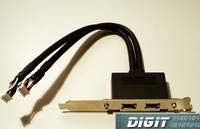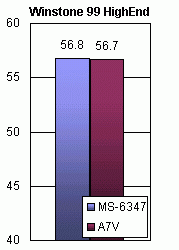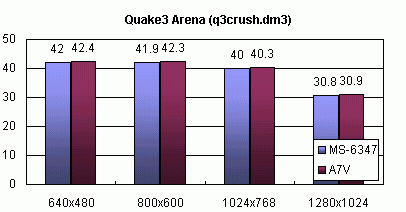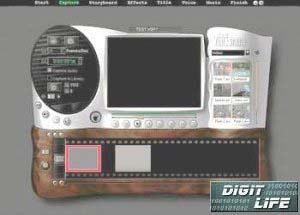 |
||
|
||
| ||
MSI company produces a wide range of motherboards based on the VIA KT133 chipset with the SocketA. Many of them are estimated at their true worth by users and awarded the prizes by the leading computer sites. However, for the first time we saw a motherboard for the AMD Athlon Thunderbird processors intended for the work station and server market - the K7T board series has received one more model - the K7T Master, or MS-6347. The boards on the VIA's chipsets pretending to work in work stations and servers were produced long time ago already (dual-processor Tyan Tiger 133, Tiger 200 (with IDE RAID), Tiger 230, MSI 694D Pro, and even with SCSI controller - the AOpen DX34 Plus), but there are no any board for AMD processors among them. However, since the AMD Athlon Thunderbird doesn't lag behind the analog models of the Intel Pentium III in speed, MSI has made a rational step having released a powerful K7T Master board for AMD supporters. Specifications: General
RAM
Expendable slots
IDE
Sound
Integrated controller/ports
Ultra 160 SCSI controller
Firewire / IEEE-1394 controller
BIOS
awake from timer, network (WOL), modem (WOM)
Hardware Monitoring
Dimensions
Complete set
The supplied CD from MSI can be useful not only for the motherboard - apart from drivers for chipsets of mainboards of Intel, VIA, AMD, ALi there you can find drivers to the popular netcards, video adapters, sound cards. Besides, there are a lot of handy utilities - from a setup program Windows 9x Xteq Systems X-Setup and Trend PC-cillin 2000 antivirus to a program for remote control of a PC - the WinVNC. Undoubtedly, the CD contains the MSI proprietary programs: PC monitoring program - the PC Alert III (together with DMI browser, Doctor Y2K and MOspeed), FSB frequency settings - the Fuzzy Logic III, BIOS's logo change - the EZ-Logo, reduced CPU temperature - the SoftCooler, automated update of the BIOS via the Internet - the Live Bios. In general, the whole 650 MBytes area of the disc is taken for exceptionally useful information. But some unpleasant things are still there: the current versions of the Fuzzy Logic and Live Bios do not support the K7T Master board. InstallationDespite the small board size the installation turned to be easy. DIMM slots are not covered with a video card of a usual length and with drive bays. Four DIMM slots of course do not allow to overpass limitation in 6 memory banks for the KT133 chipset - in the connectors 3 and 4 you can install only 1-bank modules but it still adds flexibility when choosing memory configuration. Note that the memory in the KT133 based systems can work both at 100 MHz and 133 MHz. It's set either automatically or via the BIOS SETUP. Besides, you can set a choice of CAS2/CAS3. The socket is located next to the edge of the board, that's why it makes difficult to reach the CPU and the fan when the board is inside. The same concerns the location of the ATX power connector behind the serial ports since it makes the power cable go above the CPU. The fan connector is situated far from the CPU, what is also inconvenient. Usage of big capacitors in the voltage converter for processor (3900 mF each of 8) doesn't prevent installation of big fans like the Thermaltake Chrome Orb.  AGP Pro slot, on the one hand, is compatible with all former AGP versions, and on the other hand, extends them and looks beneficial on this board. For high-consuming video cards there is an additional power connector. Configuration of the 1 AGP/6 PCI/ 1 CNR slots is chosen successfully - the board is positioned as a server one, and together with the integrated SCSI and Firewire controllers we get even 8 PCI devices. Like in the most server boards, the MS-6347 is equipped with an integrated SCSI controller. Usage of Adaptec's chips AIC-7892B and AIC-3860Q allowed realizing the SCSI Ultra160 standard and connection both of LVD and SE devices. And thanks to the simultaneous use of the fast LVD hard disc and SE CD-ROM device there won't be any performance decrease exactly due to the second chip dividing SE and LVD buses.  The on-board Firewire/IEEE-1394 controller looks like a rear but an interesting feature. The firewire adapter confuses me a bit with its large size. Usage of it in a standard case will lead to covering one of PCI slots. I think it would be better to put the connectors right on the board (be it at the expense of the second serial port) or just closer to the ATX connectors' unit, since the vast majority of cases allow installing additional external connectors above standard. For monitoring the system parameters the VT82C686A chip provides 5 voltages, 2 fans, 2 temperatures. The following voltages are measured: CPU Vcore, AGP Voltage, 3.3V, 5V, 12V. The CPU temp is measured with an external sensor, the second input is made in the form of a connector for an external thermistor. The board comes with three fan connectors - CPUFAN, SYSFAN, PSFAN, but only two of them are controlled in speed. SpeedThe operating speed has reached one of the leaders among the VIA KT133 boards - the ASUSTeK A7V. Testbed:
Winstone 99 HighEnd (1.3 version)  Quake 3 Arena (1.16n version, demo q3crush.dm3)  You can see that the boards do not practically differ in speed, what proves the chipset, the BIOS and the drivers to have been well thought out. Note a high reliability of the board - while running the tests we haven't marked either buzz or overload. OverclockingThe MS-6347 is not rich in overclocking possibilities: there you can only change FSB frequency in the BIOS. The set of values depends on the BIOS version. We had 100, 102, 103, 107, 110, 113, 117, 120, 133, 135, 137, 140, 143, 145, 150 MHz. As you can see, the most actual range today (up to 110 MHz) is given only in 5 values. We managed to overclock the AMD Athlon 800 MHz up to 856 MHz = 107x8. The Windows 2000 worked flawlessly. When setting FSB at 110 MHz the system passed the POST but stopped with OS booting. Since the board doesn't provide any possibilities in change of the voltage or of the CPU multiplier, the further rise was impossible. But considering usage of a usual fan for the Socket A, the result achieved is not that bad. (It turned out, though, that the boards applied 1.78 V to the CPU instead of 1.7V). Practical use of the Firewire / IEEE-1394The most unforgettable event in the field of motherboards and IEEE-1394 controllers was a debuting of the ASUSTeK P3B-1394 motherboard in Fall of 1999. But since that time the mainboard manufacturers are moving forward in this direction too slowly. It seems that everybody was satisfied with the USB bus. Nevertheless, the Firewire interface today has taken the solid place in computers for video processing. Considerable reduce in prices for controllers and a decision of many companies to take the digital form of video storing (even in video cameras) helped that. I was also interested in possibilities of this complete set. Bearing in mind the complexity of usage of the analog board of video input from Prolink - absence of drivers, incompatibility of formats and video codecs, lost frames, awful quality etc. - I didn't expect the new experience would be so simple. First I tries to find information on the "video camera - Firewire controller" operation in advance, and I got very little. So, I tried to fight problems myself. On the PC I installed the OS Windows 98 SE for tests. The drivers for the IEEE-1394 controller were in the OS (they are also included in the Windows 2000). After that I installed the Ulead Video Studio 4.0 Basic SE from the supplied CD. The Sony DCR-TRV110E video camera was used as an external Firewire device. Earlier I worked with the Adobe Premiere, but now simple managing of the Ulead VideoStudio just struck me. For creation of your personal video it's necessary to transfer the chosen video clips from the camera, position digital transition effects between them, add titles etc. Then, the resulting video clip is combined into a single file and may be transferred back to the video camera.  The most amazing thing is that the whole processing is done in the digital form, what prevents quality worsening. The only problem is that for each minute of DV you are to prepare around 200 MBytes of the disc area. The Ultra160 SCSI controller on the board will help you. By the way, the HDD speed is not so important anymore - I used one UDMA66 IBM DTLA-307015, the file was recorded into the system disc, and no special optimization of the Windows 98 wasn't made. Of course, such ease is mainly provided by the program, but if the hardware hadn't worked so reliable and simple, all its beauties would have meant nothing. ConclusionThe results of work with the MSI K7T Master show that the board turned out well. The VIA KT133 chipset, 6 PCI slots, AGP Pro slot, 4 DIMM connectors, Ultra160 SCSI and Fireware/ IEEE-1394 controllers - all these things in the best way stress an image of the powerful mainboard. High speed and reliability make it a perfect choice for high-efficient work stations. A bit strange is the absence of some possibilities for overclocking, but for the card intended for work station and server market it doesn't matter much. Write a comment below. No registration needed!
|
Platform · Video · Multimedia · Mobile · Other || About us & Privacy policy · Twitter · Facebook Copyright © Byrds Research & Publishing, Ltd., 1997–2011. All rights reserved. |